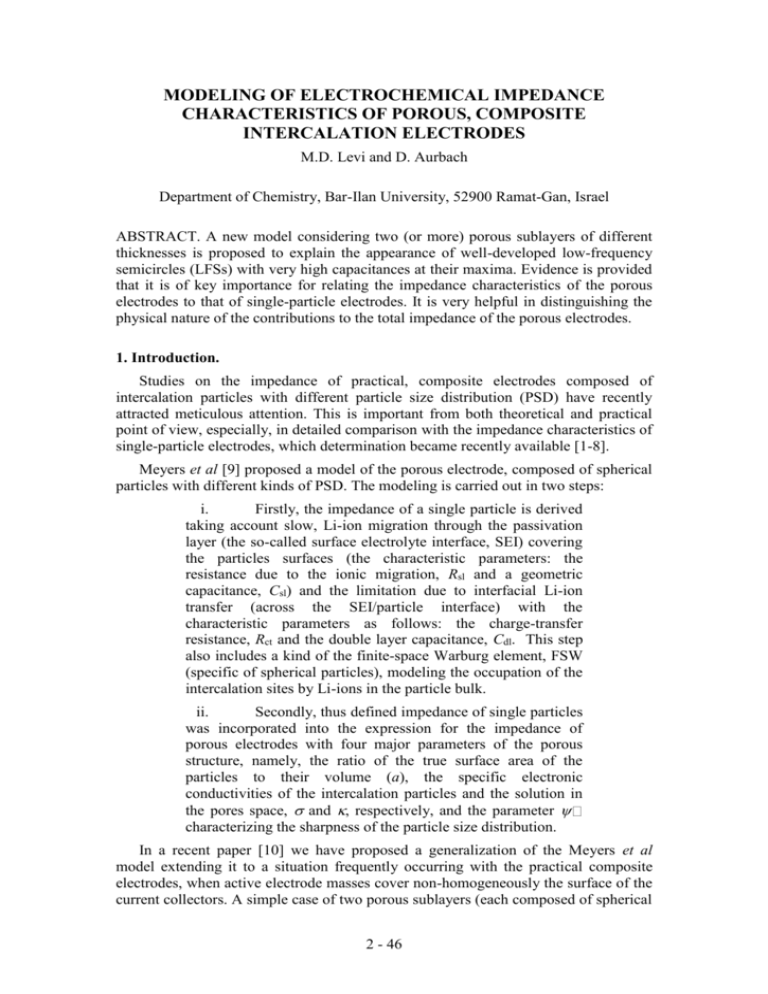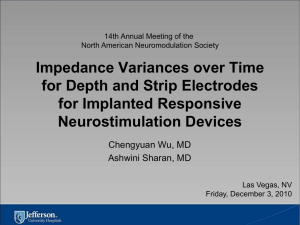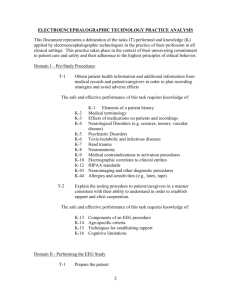Paper
advertisement

MODELING OF ELECTROCHEMICAL IMPEDANCE CHARACTERISTICS OF POROUS, COMPOSITE INTERCALATION ELECTRODES M.D. Levi and D. Aurbach Department of Chemistry, Bar-Ilan University, 52900 Ramat-Gan, Israel ABSTRACT. A new model considering two (or more) porous sublayers of different thicknesses is proposed to explain the appearance of well-developed low-frequency semicircles (LFSs) with very high capacitances at their maxima. Evidence is provided that it is of key importance for relating the impedance characteristics of the porous electrodes to that of single-particle electrodes. It is very helpful in distinguishing the physical nature of the contributions to the total impedance of the porous electrodes. 1. Introduction. Studies on the impedance of practical, composite electrodes composed of intercalation particles with different particle size distribution (PSD) have recently attracted meticulous attention. This is important from both theoretical and practical point of view, especially, in detailed comparison with the impedance characteristics of single-particle electrodes, which determination became recently available [1-8]. Meyers et al [9] proposed a model of the porous electrode, composed of spherical particles with different kinds of PSD. The modeling is carried out in two steps: i. Firstly, the impedance of a single particle is derived taking account slow, Li-ion migration through the passivation layer (the so-called surface electrolyte interface, SEI) covering the particles surfaces (the characteristic parameters: the resistance due to the ionic migration, Rsl and a geometric capacitance, Csl) and the limitation due to interfacial Li-ion transfer (across the SEI/particle interface) with the characteristic parameters as follows: the charge-transfer resistance, Rct and the double layer capacitance, Cdl. This step also includes a kind of the finite-space Warburg element, FSW (specific of spherical particles), modeling the occupation of the intercalation sites by Li-ions in the particle bulk. ii. Secondly, thus defined impedance of single particles was incorporated into the expression for the impedance of porous electrodes with four major parameters of the porous structure, namely, the ratio of the true surface area of the particles to their volume (a), the specific electronic conductivities of the intercalation particles and the solution in the pores space, and , respectively, and the parameter characterizing the sharpness of the particle size distribution. In a recent paper [10] we have proposed a generalization of the Meyers et al model extending it to a situation frequently occurring with the practical composite electrodes, when active electrode masses cover non-homogeneously the surface of the current collectors. A simple case of two porous sublayers (each composed of spherical 2 - 46 intercalation particles with two different radii, Rs1 and Rs2), which thicknesses are equal to L1 (fraction 1) and L2 (the corresponding fraction (1-1)). The implication of this two-sublayers model was that at certain combination of the parameters of the porous electrode structure, the third, low-frequency semicircle (LFS) with a very high formal specific capacitance may appear in the related impedance spectra, in addition to the high-frequency semicircle (HFS) presenting impedance of the surface layer and the middle-frequency semicircle (MFS) due to interfacial kinetics limitation for the Li-ion transfer. The objective of the present work is to derive a system of equations describing completely the properties of two-parallel porous sublayers model, providing a reasonable explanation of the high capacitance values for the well-developed lowfrequency semicircles (LFSs). Electroanalytical behavior of porous, composite graphite electrode with methyl silicate binder, prepared by sol-gel technique [11], is probably the best experimental system for theoretical modeling of its impedance characteristics since in this case, a decreased values of the both and are expected (for typical organic electrolyte solutions containing Li salt). 2. Results and Discussion. A sketch of the porous, composite electrode comprised of spherical particles of different radii is shown in Fig. 1. For simplicity, only two sublayers, L1 and L2 thick are considered. Although the active masses of practical composite electrodes present particles with different size distribution (PSD), for the qualitative consideration we assume that each sublayer is composed of two particles ("small" and "large" particles). A consideration of three major contributions to the impedance of individual intercalation particles mentioned in the introduction section lead to the following expression for the overall particle’s impedance [9]: Rct, i Z part, i Rpart, i Ys, i Rpart, i 1 j C dl, i Rct, i Ys, i Rsl, i 1 j Rsl, i C sl, i (1) with the finite-space diffusion resistive element, Rpart,i, of the form [9]: Rpart,i and with 1 Ys, i tanh j i j i tanh j i Rs,2 i 3Ds Cpart, i i 3C part, i . (2) where Ys,i-1 is a spherical analog of the characteristic function of frequency in the expression for a linear finite-space Warburg element, i.e., coth ( j i ) [10]. Here Cpart,i stands for the limiting low-frequency capacitance of a spherical particle, Rs, i is the diameter of the spherical particle, Ds is the chemical diffusion coefficient, i designates the related diffusion time constant, and is the angular frequency of the alternative current. Subscript i denotes the particles with two different radii, i.e. either 1 or 2. Rct and Rsl were previously defined (they relate to the diameters of the MFS 2 - 47 and HFS, respectively). The total admittance of an electrode comprising a mixture of two types of particles in terms of different size, 1/Zmix, is regarded as an averaged sum of the individual admittances 1/Z1 and 1/Z2 [9,10]: 1 Z mix 1 Z1 (1 1 ) , Z2 (3) where 1 is the fraction of the total capacity due to a contribution of the "small" particles (for further consideration, it is assumed to be 0.5). The distributed impedance of the porous electrode, Zporous, relates to the impedance of the mixed particles electrode as is defined by Meyers et al. [9]: Z porous 2 cosh L 1 , sinh (4) with a complex parameter of the form: 1 2 a L Z mix 1 2 , (5) where and were earlier defined as the specific conductivities of the electrolyte solution and solid particles, respectively, L is the thickness of the porous electrode, a denotes the ratio of the total surface area to its volume, and Zmix is obtained from Eq. 3. The impedance of a parallel combination of two porous sublayers ( Zmix, L1 and Zmix, L2 are the impedances of the two sublayers L1 and L2 thick considered), ZL1+L2, is given by the formulae similar to Eq. 3 [10]: 1 Z L1 L2 L1 Z mix, L1 (1 L1 ) . Z mix, L2 (6) In the following modeling, we consider the case when the thicker sublayer, L2 cover predominantly the surface of current collector, e.g. it was assumed L2 = 0.85, thus L1 = 0.15 The impedance plot calculated according to Eqs. 1 – 6 (with the numerical parameters indicated in the figure’s caption) is shown in Fig. 2. This plot reproduces qualitatively all three semicircles (i.e. HFS, MFS and LFS) which are characteristic of the experimental impedance spectra of graphite electrode [11]. The values of the capacitances related to the HFS maxima may vary (depending on the capacitances of the individual particles selected as the model parameter and the parameters of the porous electrode structure and ) between 0.1 and 10 Fcm-2, whereas the capacitance related to the MFS varies between 0.01 and 1 mF cm-2. As the dominant sublayer is thick, and the values of and are low, the capacitances at both semicircles of the porous electrode impedance plot are lower compared to that related to the individual particles. On the contrary, with thin electrodes, and for high values of and , the relevant impedance spectra exhibit a “congruent” behavior (as related 2 - 48 to the spectra of the individual particles) with a scaling factor reflecting the true surface area of the porous electrode []. 3. Conclusion The model proposed allows to reproduce semi-quantitatively all the three semicircles (HFS, MFS and LFS) appearing in impedance spectra of many porous, composite electrodes comprised of intercalation particles, and is of key importance for relating the impedance characteristics of the porous electrodes with that of singleparticle electrodes. REFERENCES 1. Nishizawa, M.; Hashitani, R.; Itoh, T.; Matsue, T.; Uchida, I. Electrochem. and Solid-State Letters, 1998, 1, 10. 2. Umeda, M.; Dokko, K.; Fujita, Y.; Mohamedi, M.; Uchida, I.; Selman J.R. Electrochim. Acta , 2001, 47, 885. 3. Sato, H.; Takahashi, D.; Nishina, T.; Uchida, I. J. Power Sources, 1997,68, 540. 4. Dokko, K.; Mohamedi, M.; Fujita, Y.; Itoh, T.; Nishizawa, M.; Umeda, M.; Uchida, I. J. Electrochem. Soc., 2001,148, A422. 5. Dokko K.; Mohamedi, M.; Umeda, M.; Uchida, I. J. Electrochem. Soc., 2001,150, A425. 6. Dokko, K.; Nishizawa, M.; Horikoshi, S.; Itoh, T.; Mohamedi, M.; Uchida, I. Electrochem. and Solid-State Letters, 2000, 3, 125. 7. Uchida, I.; Mohamedi, M.; Dokko, K.; Nishizawa, M.; Itoh, T.; Umeda, M. J. Power Sources, 2001, 97-98, 518. 8. Shu D.; Chung, Kyung Yoon; Cho, Won Il; Kim, Kwang-Bum. J. Power Sources, 2003,114, 253. 9. Meyers, J.P.; Doyle, M.; Darling, R.M.; Newman, J. J. Electrochem. Soc, 2000, 147, 2930. 10. Levi, M.D.; Aurbach, D.. J.Phys. Chem (in print). 11. Aurbach,D; Levi, M.D.; Lev, J. Appl. Electrochem., 1998, 28, 1051. 2 - 49 O.; Gun, J.; Rabinovich, L. 1600 L1 2 -Z '' / cm Solution Current collector 1200 L2 800 HFS f*=2.9 kHz, Csl=0.3 Fcm-2 MFS f*=24 Hz, Cdl=52 Fcm-2 400 0 0 R1 LFS, f*=2 mHz, CLFS=160mFcm-2 400 R2 Fig. 1. The model of a simple, non-homogeneous coating of the current collector with two porous sublayers (thicknesses L1 and L 2) comprised of intercalation particles of two different radii (R1 and R2); 800 1200 1600 Z ' / cm 2 Fig. 2. Nyquist plot calculated according to the model using Eqs. 1-6. The following parameters were involved in the calculation. “Large” particles: Rs,1 = 4 m, (Rpart = 336 cm2, Cdl = 100 Fcm-2, Rct = 88.1 cm2, Csl = 1 Fcm-2, Rsl = 80 cm2). “Small” particles: Rs,1 = 2 m, (Rpart = 84 cm2 , all other parameters as that for “large” particles). The porous structure parameters: a = 5x103 cm-1, = 5.5x10-5 1 cm-1, = 10-5 -1cm-1, L1 = 0.04 cm, L2 = 0.0003 cm, L1 = 0.15 and L2 = 0.85. 2 - 50






